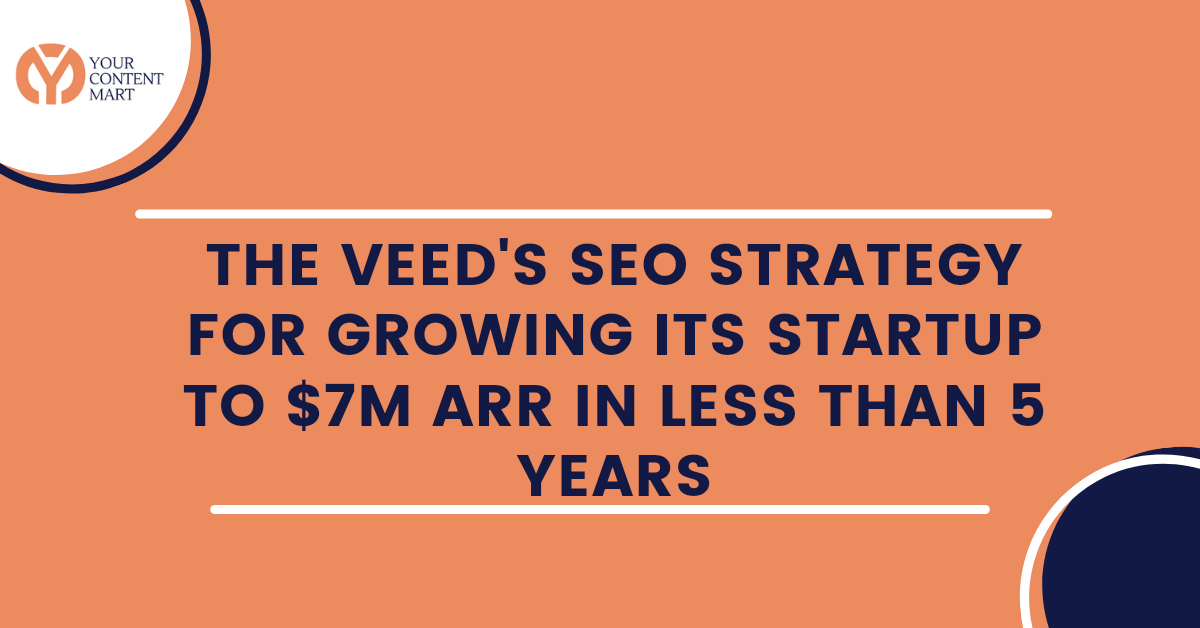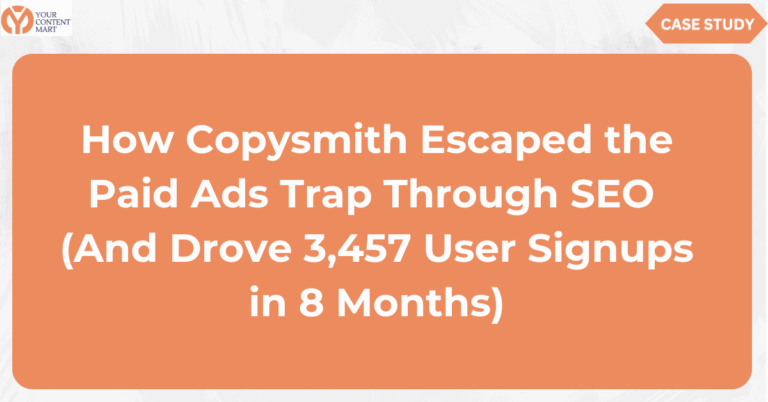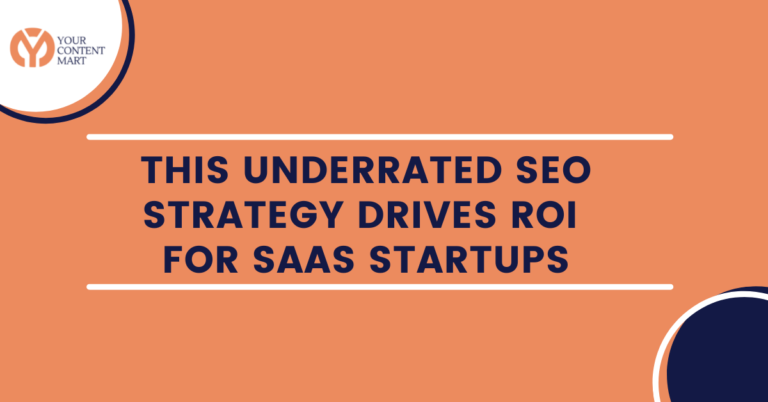In 2017, Sabba Keynejad and Timur Mamedov founded Veed, an online video editing software, after meeting at an online hackathon.
Two years after, they pitched investors at Ycombinator but didn’t make it to the final selection because they had no paying users and MRR.
Frustrated by the outcome and after another failed attempt to get accepted into YC in 2020, they went all-in to bootstrap their startup.
Five years after launching the London-based startup, they’ve achieved the following:
- Over 1 million active users.
- 1.5 million+ organic traffic visitors monthly.
- $7M in Annual Recurring Revenue (ARR).
- 25,000+ paying customers.
- Raised $35 Million in Series A funding.
Here’s a quick look at Veed’s growth in the last few years.
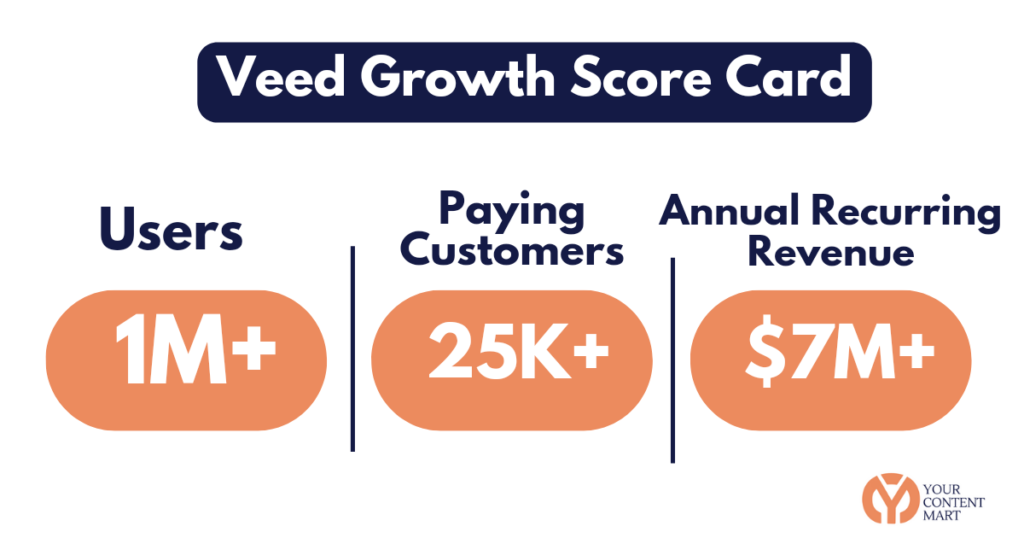
So, how did this bootstrapped SaaS startup achieve these impressive results in an industry valued at $1.94B in 2019?
That’s exactly what I’ll be covering in this post.
After reading this article, you’ll know the specific SEO strategy that has helped Veed achieve tremendous success despite all odds.
You’ll also learn how to apply some of their tactics to grow your SaaS startup using SEO.
Let’s get started…
TABLE OF CONTENTS
What Veed Did To Gain Mindshare and Market Share In The Online Video Editing Industry

One of the biggest challenges for SaaS startups is getting discovered by your target audience.
Truth is…
If no one knows that your software exists, they won’t even use it.
Before Veed launched, other popular editing tools such as Wevideo, Animoto, Kapwing, Magisto, and Adobe Premiere Pro existed. Their target audience used these to edit videos and perform other video-related tasks.
This means that the company should care so much about becoming known as a video editing software in that niche.
And guess what?
In less than five years, they achieved that feat.
Compared to its top competitors, Veed performs extremely well in search, which shows that more people discover the software whenever they need a video editing solution online.
Here’s a quick overview of the organic search scorecard of Veed Vs. its top competitors.
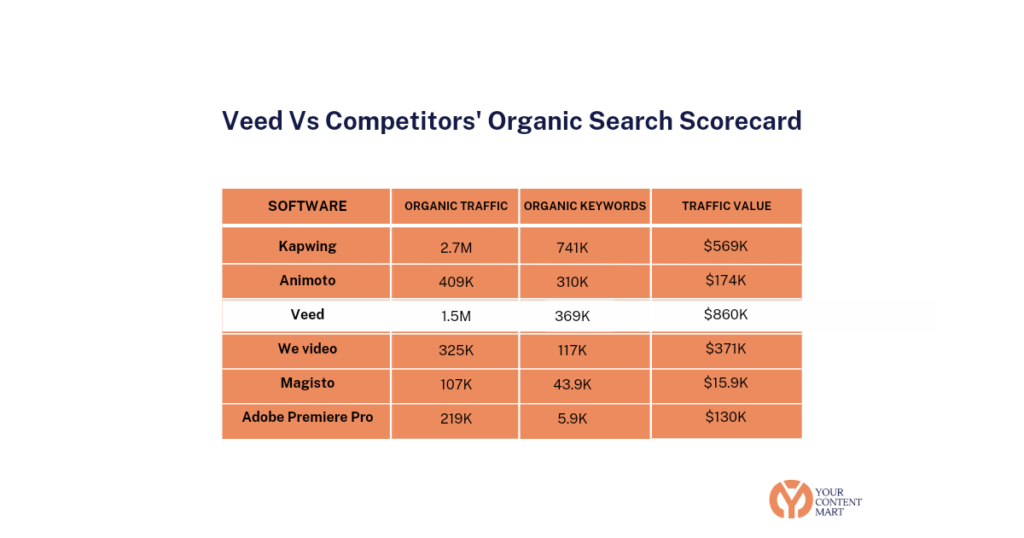
Here is the most interesting part…
They focused less on writing blog posts to get these impressive results.
Yes, you read that right!
So, what did they do?
They identified their target audience’s pain points and Jobs To Be Done and built complementary tools to help them. Then, they offered them for free with no strings attached.
They used a common subdomain (/tools) for each of them on the website.
Today, these free tools contribute about 73.33% of Veed’s overall organic traffic.

Before I delve into how they’re using these tools to acquire user signups at scale, here’s what they’ve achieved traffic-wise from these tools.
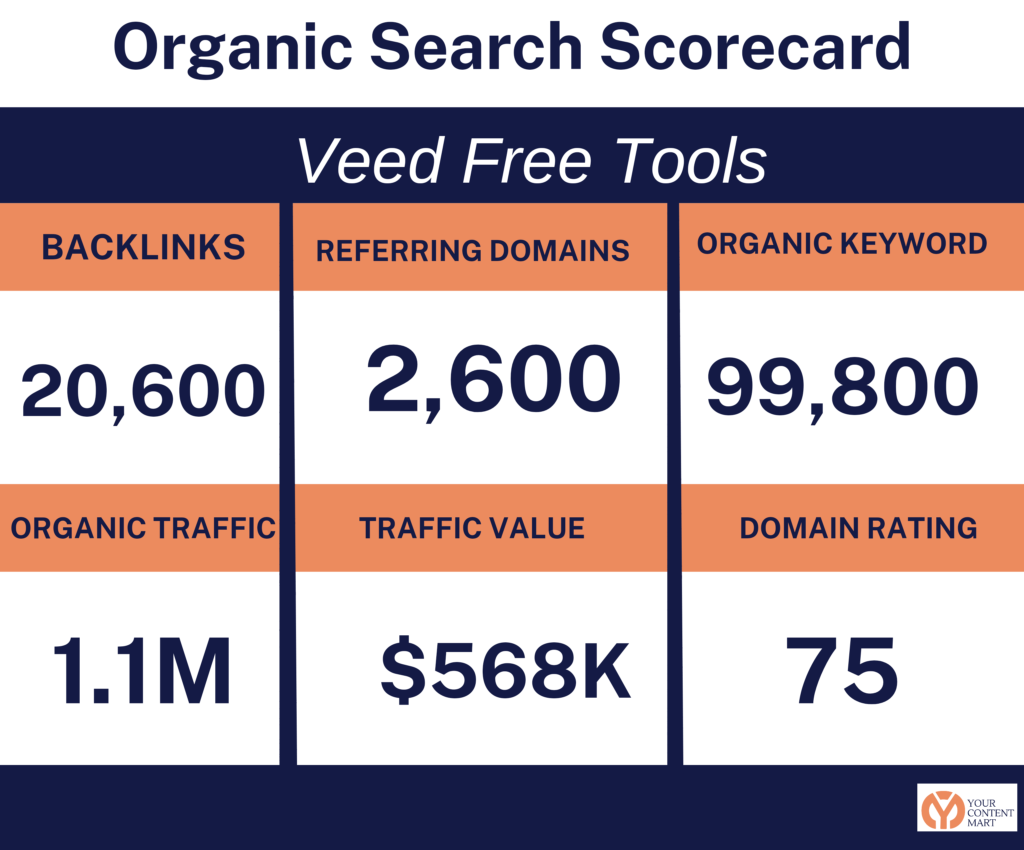
Here is another striking fact…
They didn’t build just one free tool to drive qualified traffic and acquire user signups at scale. Instead, they built an empire of about 250 tools to get the results they’ve achieved over time.
And guess what?
It works really well for them.
In context, the video compressor free tool drives about 468,000 organic traffic visitors every month, which is more than double the traffic that Veed gets from its blog of 193 posts.
Below is the organic search scorecard of the Veed’s blog compared to that of the video compressor tool:


According to Ahrefs, here are the top 10 complementary tools on Veed’s website and the organic traffic they’re getting from each one.
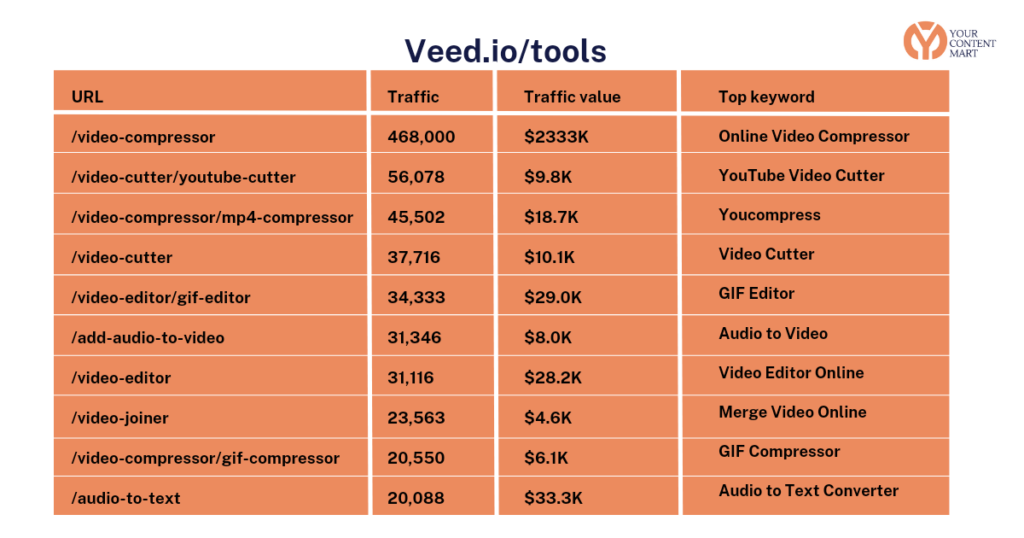
By going after these video-related keywords with these free tools, Veed can rank high on Google for them and dominate the SERPs in their niche as well.
One impressive thing about these keywords is that they’re related to the pain points of their target audience.
Since Veed is an online video editing tool, they’re looking to attract anyone who wants to edit video online without using complex tools quickly and easily.
While all these complementary tools aren’t a core part of the product, it helps them bring anyone interested in video editing into their ecosystem, show them value upfront, and then bring them on board to use their paid solution.
Truth is…
No one will know that these free tools exist if Veed isn’t distributing them well enough. So, let me show you how Veed leverages SEO to distribute these free tools.
How Veed Positioned The Free Tools To Rank High On Google For Its Target Keywords
The 250+ free tools by Veed are ranking for over 6,000 keywords in the top 3 positions on Google.
In the United States alone, they’re ranking for 1,222 keywords in the number 1 position (occupying the top spot and featured snippets).

Here are some of the keywords they’re ranking high on Google for.
- Ranking number 1 for the keyword “YouTube Cutter,” which has a global search volume of 48,000.

- Ranking number 1 and occupying the featured snippet for the keyword “how to add subtitles to a video,” which has a global search volume of 12,000 and a CPC of $5.
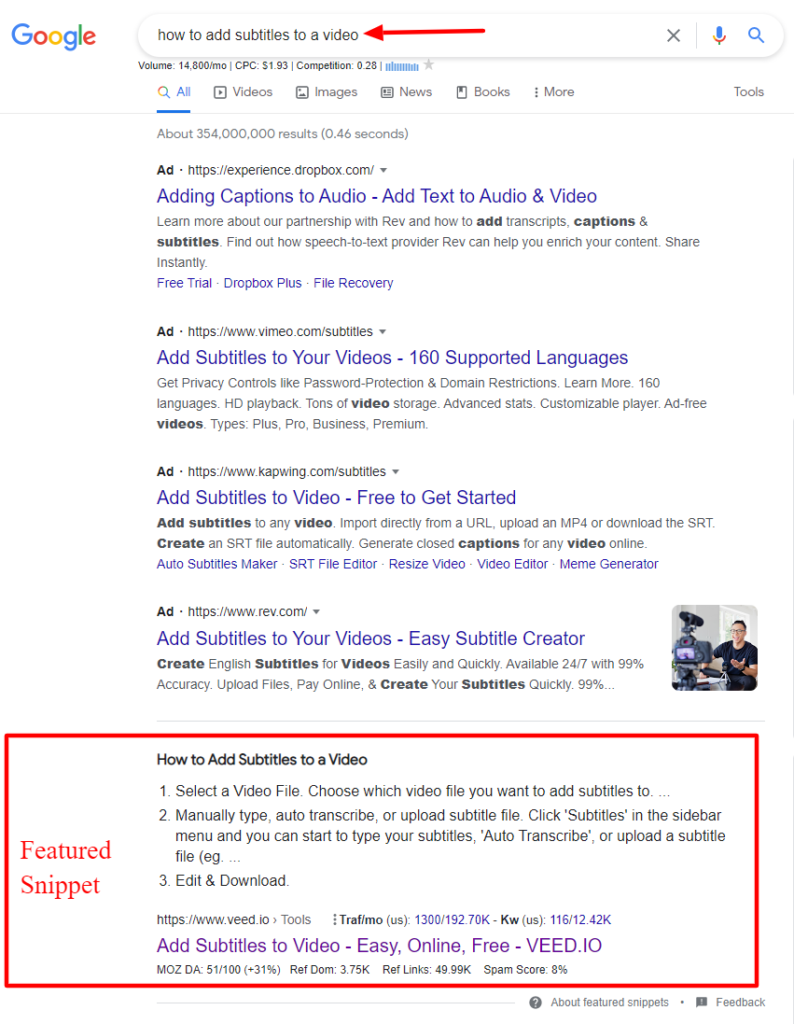
- Ranking number 1 and occupying the featured snippet for the keyword “audio to text,” which has a global search volume of 21,000 and a CPC of $11.

To rank these tools high on Google, Veed must be doing something right SEO-wise.
So, let’s analyze what that is and how you can replicate it for your SaaS startup.
How Veed’s Programmatic SEO Strategy Fuels a 1M+ Organic Traffic Engine
Listen to me…
The Veed’s tools aren’t ranking high on Google by mistake.
Instead, they’re strategic with their on-page SEO, which helped them get impressive results.
I analyzed the different landing pages of these tools they’ve built so far and found a common trend. This shows that they’re most likely leveraging programmatic SEO to build them at scale.
If you intend to build a landing page for your free tool, you could also do something similar to them.
To show you how this works, I’ll use the “video compressor” free tool landing page as an example.
Starting from the URL, here’s what it looks like: <https://www.veed.io/tools/video-compressor>.
While this is basic on-page SEO, it’s good to point it out. As you can see, they used the exact keyword they wanted to rank for in the URL.
Even though you could rank for other keywords without necessarily using them in the URL, you stand a better chance of ranking for a specific keyword if you used it in your URL.
The title tag and meta description are other important on-page SEO factors to tell Google exactly what you want to rank for and convince searchers to click on your page on the SERPs.
For Veed, they chose a descriptive and not an exact match title tag which is <Compress Video Online – Reduce File Size, HD – VEED>

Even though they didn’t use the exact keyword, they wanted to rank for in this case. Anyone searching for a video compressor wants to “compress video online” and “reduce file size,” which is still semantic and would be understandable to Google’s algorithm.
Beneath the meta description, there are highlighted links to other relevant video compressor tools, which I’ll talk about shortly.
On the main tools page, there’s an exact match H1, which tells Google the exact keyword they want the page to rank for.

Since they wanted to rank the page for “video compressor,” they used the keyword as the H1, which is the most important heading on a page.
The H1 is followed closely by a descriptive H2: “compress videos without losing quality.”

This is good SEO copywriting in action. For most people who want to compress a video online, one of their biggest fears is losing the quality of the video after compression. This H2 allays their fears and also uses a keyword related to the primary keyword in the copy to tell Google what the page is about.
There’s a paragraph beneath the H2 that shows the reader why they should use Veed’s video compressor over others.
The next section after the descriptive H2 is a keyword-rich “How-To” section.

Adding this section is important because anyone searching for the keyword “video compressor” is looking for how to compress a video. To show Google that this is a step-by-step process, they used the proper hierarchical subheading structure here.
Another essential section on the landing page is the video embed.

As you can see, the Veed team embedded a YouTube video tutorial using the keyword “Reduce Video File Size” as the H2.
That keyword itself has a monthly search volume of 7,000. Including it shows Google that it’s relevant to the page. And no wonder they’re currently ranking in the top 5 positions for that exact keyword.
After this, the next component of the landing page is where they mention the benefits of using Veed’s video compressor tool.
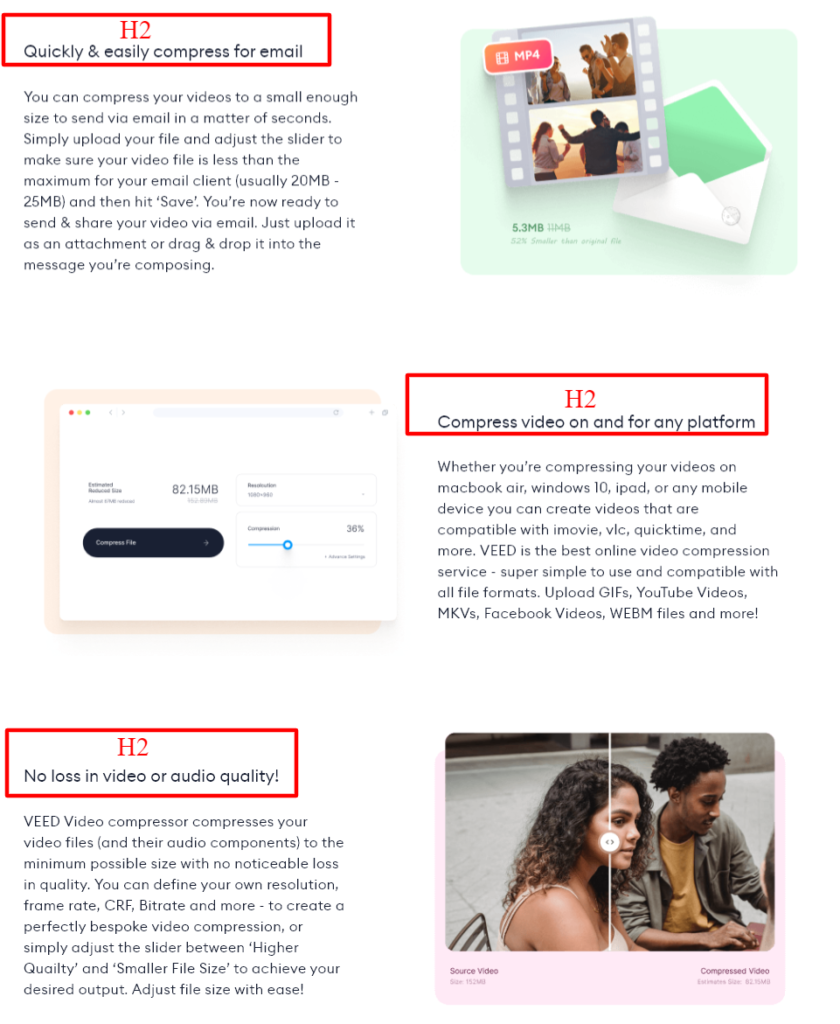
Each of these is in H2 and followed by a short paragraph explaining exactly what the subheading means. One thing to notice here is how Veed uses semantic keywords relevant to what the tool is about.
In the subheading about “Compress video on and for any platform,” there’s a paragraph that goes like this:
“VEED is the best online video compression service – super simple to use and compatible with all file formats. Upload GIFs, YouTube Videos, MKVs, Facebook Videos, WEBM files, and more!”
As you can see, this is both a combination of SEO and copywriting. Most of these keywords are strategically used to show the reader that the tool is what they need and rank high on Google.
The Frequently Asked Questions (FAQs) section comes next.
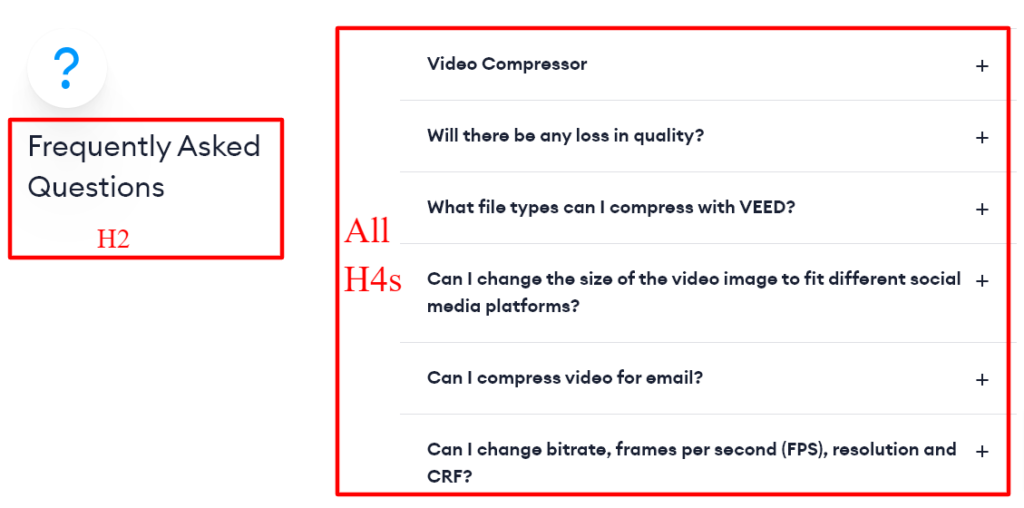
The goal of this section is simple. Answer any question that anyone who stumbles on this page might have before using the tool. As you can see, each of the questions is specific and relevant to the main keyword they’re targeting.
Another smart strategy by the Veed’s team is to add internal links to relevant video compressor tools under the “Discover More” section.

This serves two purposes.
One, it makes it easy for anyone on this page to discover other relevant tools they might need for compressing videos.
Two, it helps Google recognize how closely related those pages are. And by doing this, Google added jump links to these internal links (tools) directly on the SERPs, as I mentioned previously.
The next section is for social proof. Even though this isn’t an on-page SEO play, it’s an essential addition from a conversion standpoint.

Adding testimonials from previous Veed users shows the prospect how others have successfully used the software for various video editing purposes.
Veed also shares relevant informational content for the reader from the landing page.

This is also for internal linking purposes and to show the reader other informational content pieces available on the website.
The final section is the Call To Action (CTA) box telling the reader exactly what to do next.

Since anyone who stumbles on this page is most likely looking to compress a video, the CTA used in this case is “Choose Video.”
Right before the CTA, they subtly tell the reader other things that Veed can do for them. For example, the sentence “VEED is the one-stop-shop for all your video editing needs.” aligns expectations and tells the reader precisely what the platform is about.
In summary, here are the ten different sections on Veed’s free tool landing page, which makes them rank higher on the SERPs and drive tons of user signups.
- Exact match H1
- Descriptive H2
- How To Section
- Relevant YouTube video
- Benefits of using the tool
- Frequently Asked Questions (FAQs)
- Internal linking to other relevant tools
- Social proof
- Relevant informational content
- Call To Action
You can as well use a similar on-page SEO structure for the landing page of your free tool. That way, it stands a better chance of ranking high on Google for your target keywords.
Why Veed’s Complementary Free Tools Strategy Works Really Well

In less than five years, Veed went from a rejected startup at Ycombinator to acquiring over 1 million users, with an Annual Recurring Revenue (ARR) of $7 million.
The core of their SEO strategy is simple.
Build complementary tools related to the software’s core product and offer it to users for free.
So far, that strategy seems to work really for them, as they now generate over 1 million organic traffic users every month from these free tools alone.
Below are the four things they did to make this a successful growth lever for the startup.
1. Focus on the audience’s pain points

Most SaaS startups copy the exact SEO strategy of the top competitors in their niche. While this works in some cases, it’s not sustainable.
The reason is simple…
If your competitors are killing it SEO-wise, chances are that most of the keywords they’re ranking for are super competitive, and it will be a tall order for a startup to rank for it.
Aside from that, most of the keywords they target might not be relevant for the current stage of your business.
For Veed, they paid much attention to listening to their customers and prospects. And this helped them immensely.
If you check the keywords they’re targeting with these free tools; you’ll observe that they’re related to the pain points that anyone who does video editing online might be facing.
Below are the top keywords they’re ranking for in the top 3 positions on Google in the United States.
- Compress video
- Mp4 compressor
- Add music to video
- YouTube cutter
- Add audio to video
- Add text to video
- Compress MOV file
- Video to text converter
- Crop YouTube video
- Subtitle generator
By going this route, they could attract their primary target audience quickly and easily.
That said, if they went after keywords that their target audience cares less about, they’d most likely not get similar results as they’re doing right now.
2. Target keywords with an existing demand
If you want SEO to work for your SaaS startup, here is the mindset shift you need to have.
Treat SEO as a demand-capturing channel instead of a demand-generating channel.
Here is what that means…
Instead of targeting keywords you feel people should search for, go after keywords with existing demand.
If you focus on the latter, your chances of getting results from SEO are higher. Otherwise, you might create SEO assets that no one is interested in.
This is one of the things that the Veed’s team got right with the free tools.
In most cases, they targeted keywords that already have moderate search volume on Google.
This is the same approach that Coschedule uses for its competition-free content marketing strategy.
While it is impossible to say if these keywords have high search volume in the early days of going after them, what is clear is that they were intentional about the keywords they go after, and that has paid off for them.
Below are some keywords they are currently targeting with its estimated search volume, according to Ahrefs.
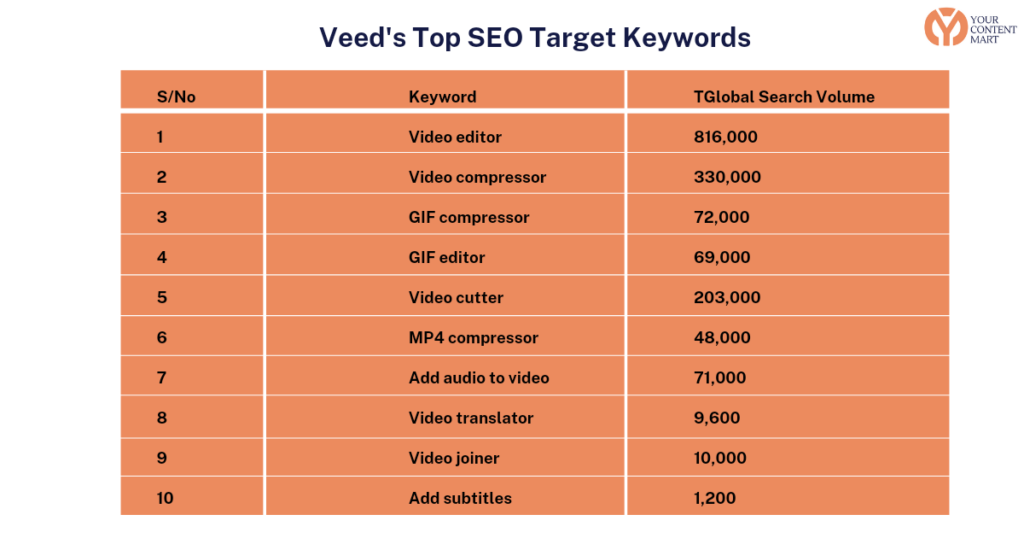
As you can see, these are keywords that their target audience is interested in and actively searching for. Hence ranking high for them means they’ll be capturing this huge existing demand.
3. Nail the search intent
One of the biggest SEO mistakes that marketers make is to pay less attention to the search intent of any keyword they’re targeting.
Truth is…
Search intent is a ranking factor. It can make or mar your ability to rank high on Google for your target keywords.
Not only that…
If you don’t nail the search intent, your target audience won’t click on your page from the SERPs. Even if they do, they’ll most likely bounce off immediately since your page didn’t meet their expectation.
For Veed, they understood the search intent for “tools-related keywords” and focused exclusively on that.
Instead of writing blog posts to target a keyword where the searcher is looking for a free tool, they built those free tools instead.
This is a game-changer, and I strongly believe it’s a huge contributor to the success of this strategy.
One of the easiest ways to know the search intent of a keyword is to perform a quick Google search and analyze the top-ranking pages on the SERPs.
Let’s say you want to rank for the keyword “add audio to video.”
A quick Google search shows that these are top-ranking pages on the SERPs.

As you can see, these are free tools ranking in the top spots on Google for this keyword. This shows that if you want to rank for a keyword like this, you should also focus on building a free tool.
While it’s possible to rank a blog post for a tool-related keyword, you stand a better chance of ranking high on Google and converting a large chunk of the traffic into user signups and paying customers if you built a free tool.
4. Offer all the value upfront
Most SaaS startups build free tools and gate them. While there’s absolutely nothing wrong with that, I don’t believe it’s a strategy that works well if your goal of creating the free tools is to attract your target audience.
The reason is simple…
Anyone searching for a free tool on Google is most likely looking for a tool they can use for free without paying a dime or creating an account.
If you gate the free tools, you’re most likely limiting the number of people willing to try it out. Hence, attracting your target audience to the main product will be more difficult.
For Veed, they offered the value upfront for all their free tools. This makes it super easy for anyone to try them out and use them without creating an account.
For instance, if you want to use Veed’s video compressor tool. All you need to do is click on the “Choose Video” option from the homepage.

Once done, you’ll be redirected to a new page that looks like this.

As you can see, you can upload a video file, drag and drop one, and upload a YouTube or Dropbox link, all for free.
If you choose to upload a file, here’s the new interface you’ll be redirected to.
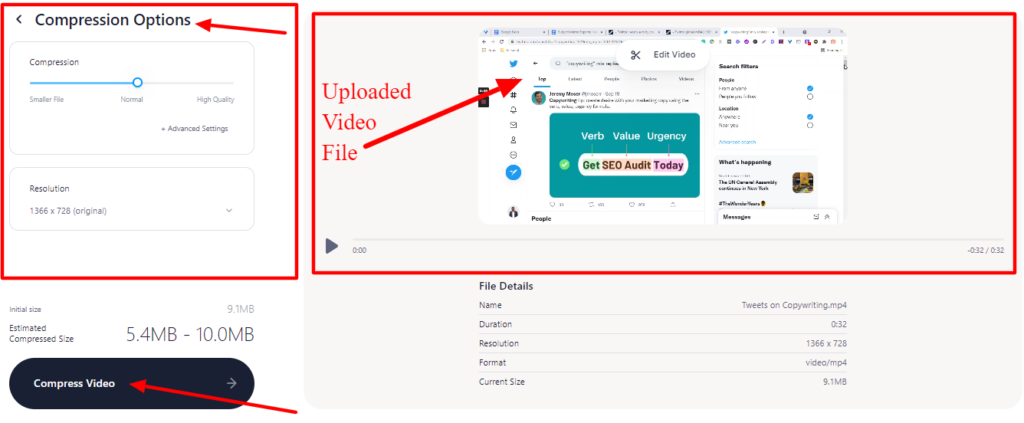
After the video is compressed, here is what the output looks like below:

With this super low friction, anyone can better understand how the tool works. And if they want to get more done, they can upgrade to a paid account.
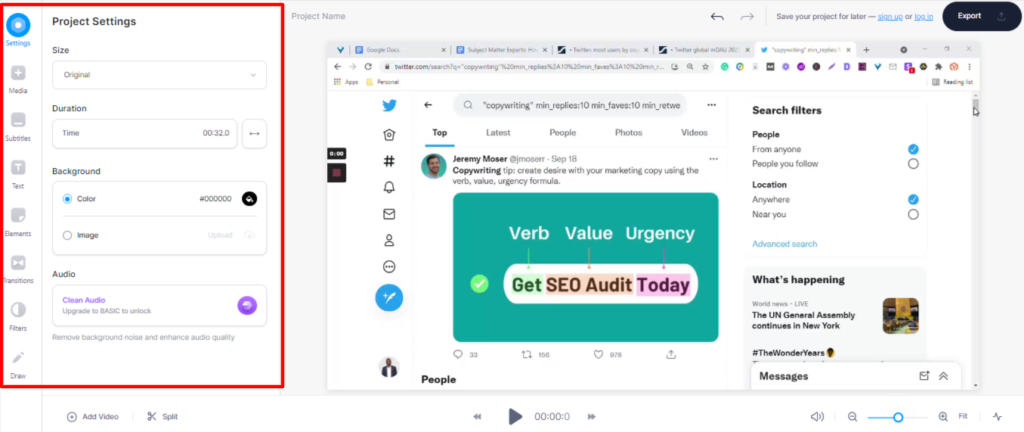
With this super low friction, anyone can have a better understanding of how the tool works. And if they want to get more done, they can upgrade to a paid account.
As you can see, building an ungated free tool that offers all the value upfront is a smart SEO strategy. This is the exact approach that Signaturely used to acquire 30,000 user signups in 12 months.
SEO Isn’t About Writing Blog Posts Alone
Most startup founders and marketers think that SEO is about creating blog posts alone.
As you can see from Veed’s strategy, this isn’t the case.
Truth is…
There are many SEO playbooks that you can leverage to drive business results for your startup.
In the case of Veed, they built complementary free tools that helped their audience solve the pain points they have.
Today, those tools generate over 1 million organic traffic visitors every month.
What does this show?
Building free tools is an underrated SEO strategy that can drive immense results for your SaaS startup.
While it might not be feasible for your startup to achieve the same results as Veed using this strategy, you should consider building a bunch of them if they align with your target audience’s pain points and jobs to be done.
Aside from free tools, other pain point SEO assets you should create for your SaaS startup include:
- Comparison posts
- Alternative posts
- Best X JTBD posts
- Use cases landing pages
- Features landing pages
Want to implement and achieve a similar feat for your SaaS startup?
We got you covered.
At Your Content Mart, we help early-stage B2B SaaS startups acquire more users and grow MRR using ROI-driven content marketing.
You can schedule a free strategy session with our Lead Content Strategist to see how we can fuel your company’s growth using content marketing.

